Planning consent is required in the UK when commercial peat extraction takes place. One of the conditions imposed as part of any such consent relates to the after-use of the land. Given the loss of lowland peat bog habitat both in Britain (e.g Lindsay & Immirzi, 1996) and elsewhere across Europe (e.g. Bragg & Lindsay, 2003), there is general recognition that peat bog sites subject to commercial peat extraction should have restoration to peat bog habitat as the prime target of after-use management.
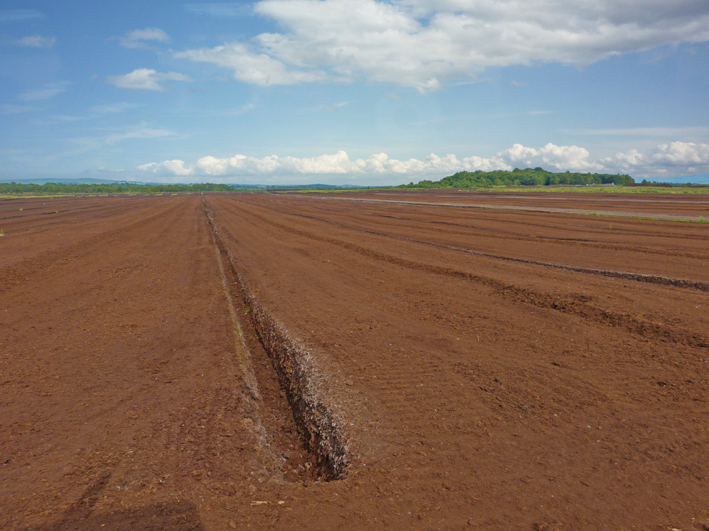
The residual thickness of peat remaining at cessation of commercial extraction is a critical factor in determining whether bog conditions can be re-established immediately on the site or whether an extended (and often indeterminate) period of fen conditions will prevail before ‘ombrotrophic’ bog (i.e. rain-fed bog) conditions can re-establish. A concept frequently encountered in planning applications and consents is that of “an average minimum depth of 0.5 m” to remain as the residual peat depth at cessation of commercial working.
Scottish Natural Heritage commissioned us to examine the basis of this concept and determine whether available scientific evidence supported this concept or instead indicated that a different depth of residual peat is appropriate if the after-use objective and consent condition is for bog habitat to be re-established as quickly as possible.
Our review of the available scientific evidence indicates that there is no supported case for “an average minimum depth of 0.5 m”. Furthermore the available scientific evidence indicates that if the residual peat depth is less than 2 m then restoration is likely to lead to a vegetation which is essentially ‘poor fen’ rather than ‘ombrotrophic bog’, while the timescale for such poor fen to develop into true bog is unclear but likely to be measured in centuries rather than decades.
The key messages of our report, now available from SNH, are therefore that for new consents on sites where more than 2 m of peat remains across the site, planning consent should require that no part of the site (other than areas at the margins) be left with less than 2 m of peat. On sites where some parts of the site already have less than 2 m of residual peat, commercial extraction should cease at the earliest opportunity in order to minimise the extent and duration of poor-fen development.
Category: Uncategorized
Merlin Magic – colour illustrated edition, and update
Unfortunately the colour-illustrated edition of Merlin Magic has been removed from my Blurb Store window in error. It has now been re-instated with a new link:
Furthermore, given the relatively high postage costs charged by Blurb for the purchase of individual books, I am investigating the possibility of selling the various editions (colour and b+w illustrated editions) direct through my own store linked to this website. This should significantly reduce postage costs for purchasers of individual volumes. I will post an announcement soon when I have investigated the mechanics of doing this.
Merlin Magic – black & white illustrated version now available
When three people decide to live in Brittany for a month on a boat the size of a small wardrobe – a wardrobe which can barely accommodate two – the plan has certain obvious flaws, not the least of which being that they have neglected to inform the maritime museum (in which they plan to stay) of their plans… Moreover Dave, who will set off into the Breton countryside for two weeks while Ceci joins me on Merlin, decides to leave his waterproof hiking boots behind in Captain Haddock (“because it’s summer”). This is not a good decision…
This book is now available as a paperback edition with black & white illustrations, thus making it considerably cheaper than the edition with colour illustrations and only slightly more expensive than the Amazon Kindle edition without illustrations. It is perhaps worth pointing out that I receive less than £1.00 for each book sold whatever the edition, the remainder going to the publisher. Such is the penurious life of an author…
Munsary Monitoring, Caithness : Part 3
Dawn on 25th July brought with it huge streamers of cirrus above drawn-out banks of stratocumulus which, once again, steadily thickened from the west (as ever, the panoramas are worth clicking on to see the full image):

This time, however, the rain held off and the sky even began to clear somewhat as the day wore on. This made hunting for our permanent transect markers with our Bill Wyman Signature metal detectors (yes, still that Bill Wyman! – he loves metal detecting and designed these himself…) a rather more pleasant business than had been the case for the past couple of days:
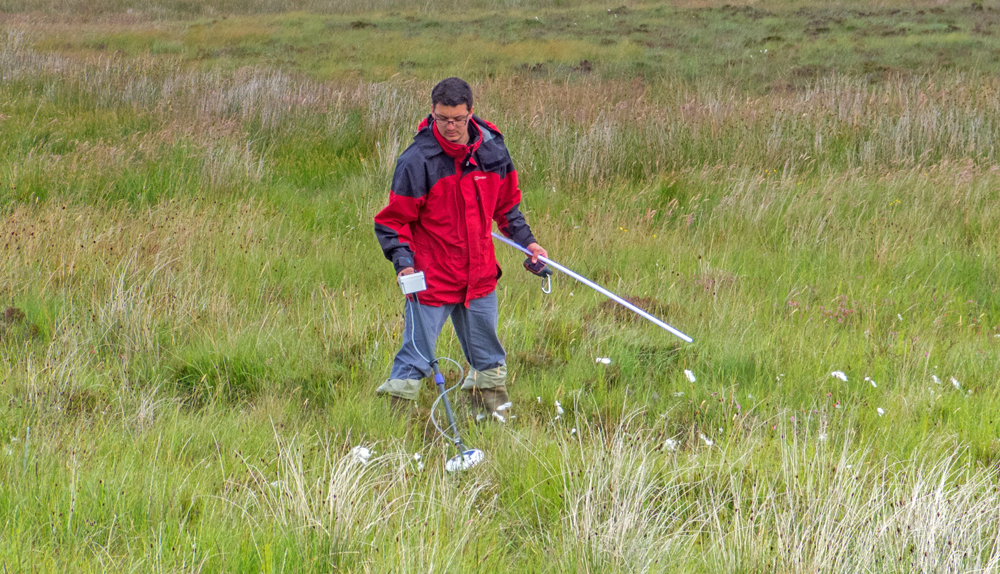
The look on Jack’s face says everything about the satisfaction of finding yet another of our precise transect locations in this vast open landscape – thanks Bill…!!
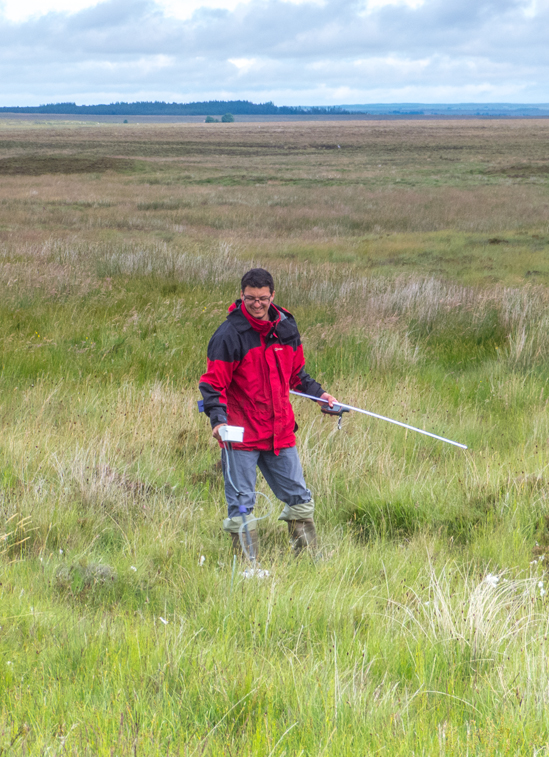
Munsary Cottage is soon to lose its roof because it is already unsafe and would cost large sums of money on a regular basis to maintain. Consequently the decision has been made to remove the roof and use the walls for all-weather display materials, while at the same time providing some shelter from the driving wind and rain for anyone visiting, or working on, the site. These photos are therefore a final farewell to the Munsary Cottage roof – as well as showing the rather confused state of the sky today, with stratocumulus building up to cumulonimbus which dumped localised showers in places, but happily we all stayed dry for once:
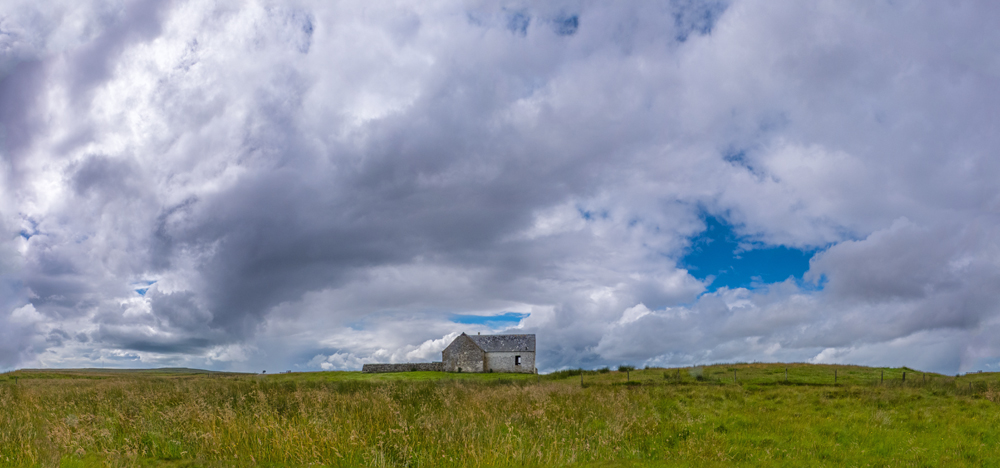
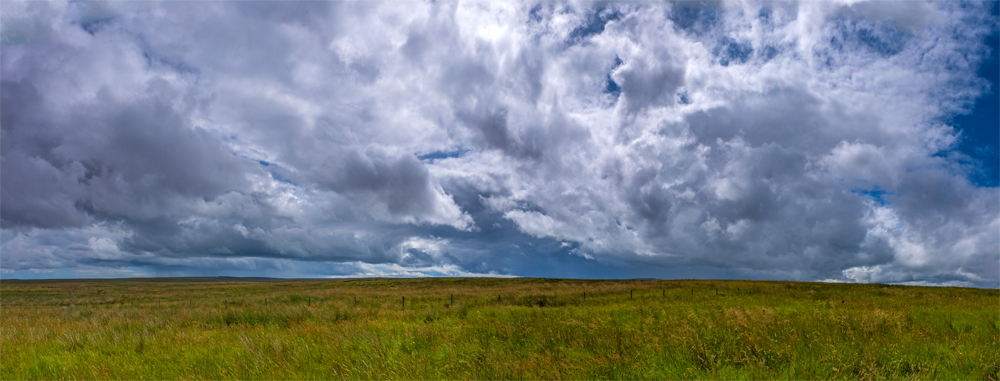
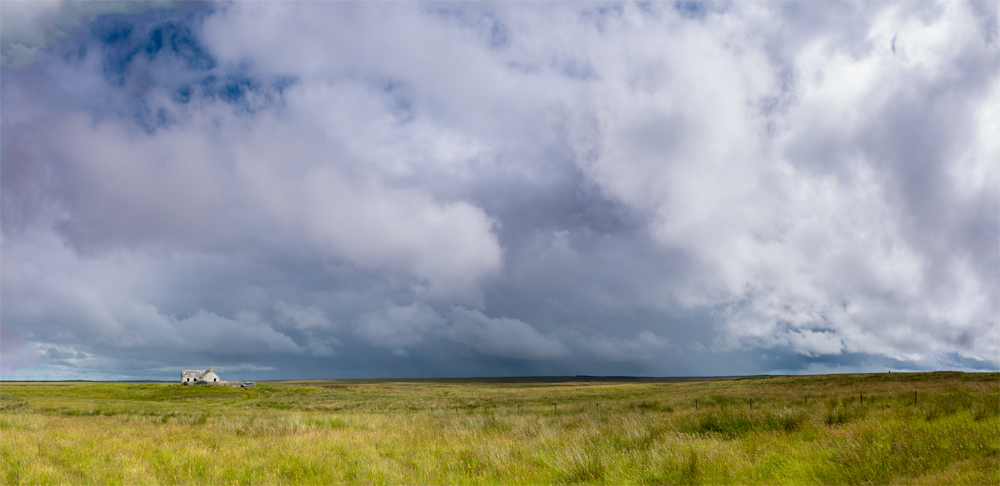
The three teams had scattered to differing parts of the Reserve today, and as Jack and I were recording several transects quite close to Munsary Cottage we arrived back at the cottage before the other teams. We therefore had time to watch the pair of pied wagtails (Motacilla alba) who had made a nest in the dilapidated cottage bringing food to their increasingly noisy young. Meanwhile the builders brought in by Plantlife to make the cottage safe were very careful not to disturb the youngsters in the nest:
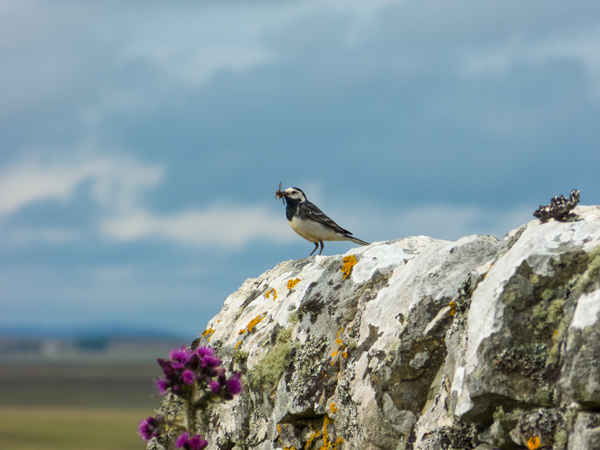
One parent had managed to catch a very large hover fly (Syrphidae Family, possibly Eupeodes corollae? which looks possible from the NBN Gateway distribution map). Anyway, a juicy morsel for some lucky nestling:
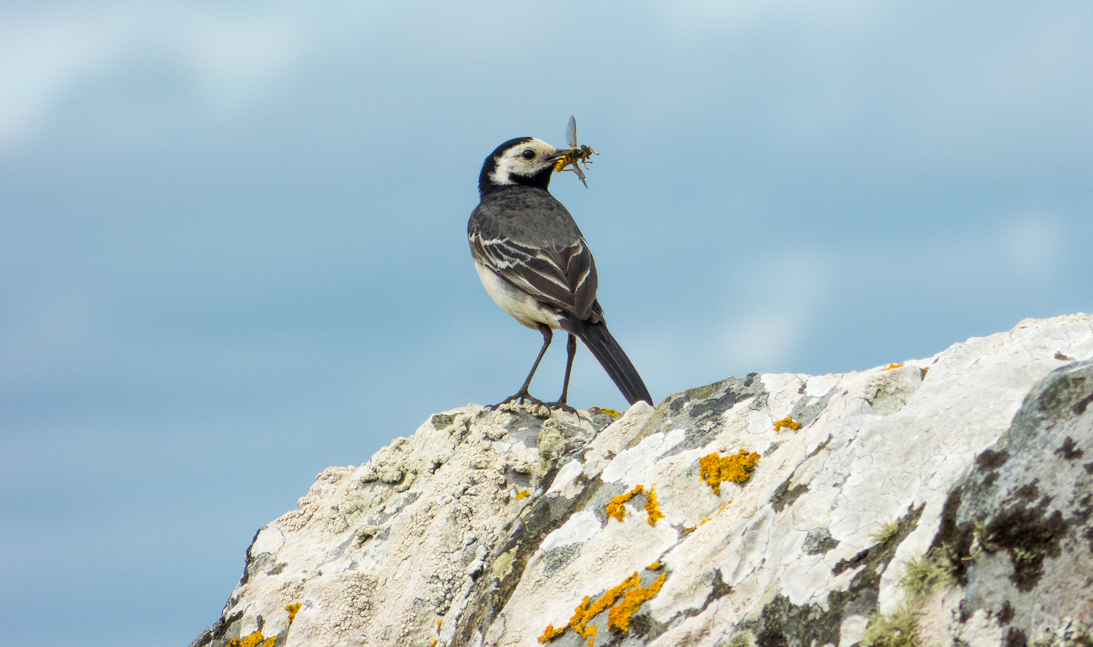
Meanwhile a male stonechat was scolding us roundly with his stone-clinking call from the fence that surrounds the cottage:
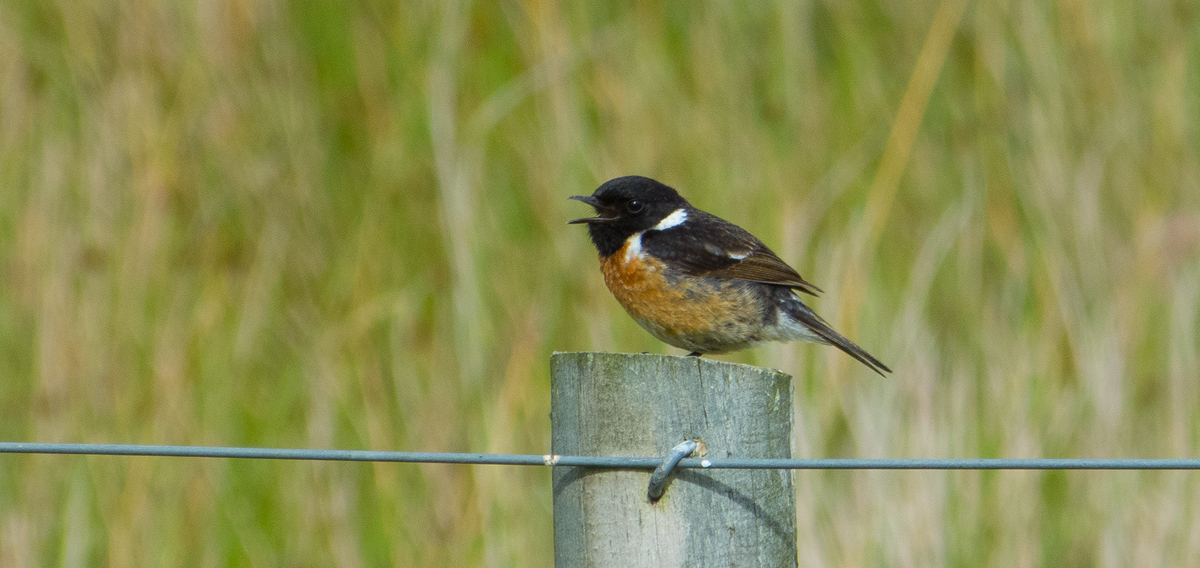
By the time we’d left the site it was getting late and we hadn’t really sorted out dinner, so I suggested doing a quick and easy but fun meal that my wife Hiroe often conjures up when we are in a rush: sliced tomatoes with fresh coriander, sliced avocados, sliced mozarella, garlic bread with dipping olive oil, olives, smoked salmon and prawns. Minimal preparation, only the bread needs heating, and we ate ourselves to a satisfied standstill:
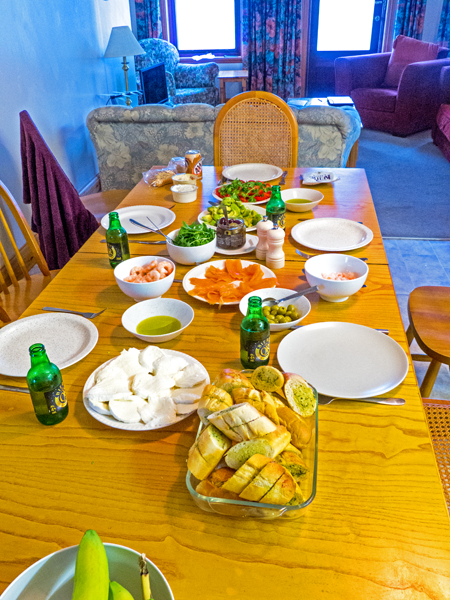
I should add that although this was an unplanned surprise meal, the various chef rotations during our stay all produced meals which were not merely filling and satisfying for fellow hungry fieldworkers, but also really tasty – always an important element in keeping a survey team happy – and the added bonus of Jerushah’s cake baking and desserts provided a very pleasant way of rounding off the meals.
The following day was a long steady slog to the south-western region of the Reserve. The sky was pretty gloomy all day, but at least it kept us cool for the long uphill slog on the way out and what felt like the even longer slog back to the cottage at the end of the day:
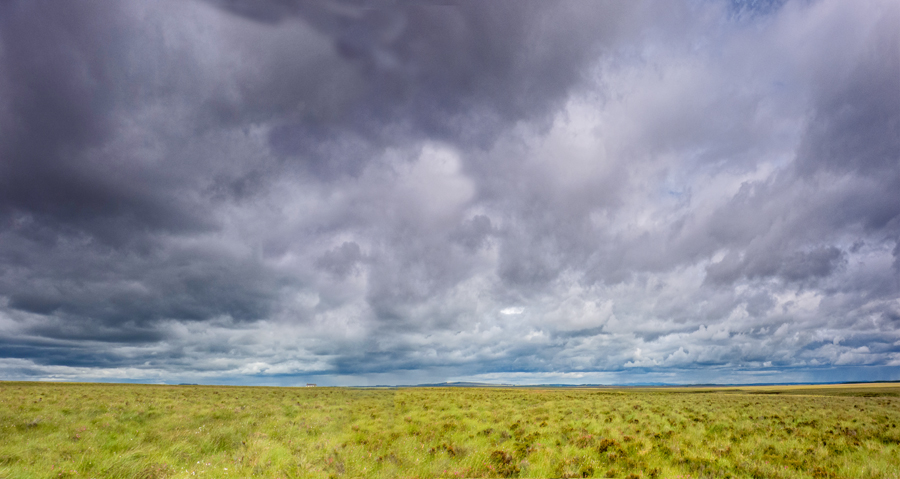
The 27th July was the longest day of all. Jack and I headed for the far south-eastern corner of the Reserve – the furthest point from Munsary Cottage – while John and Sam headed for the far south-western corner – still a long slog. Our journey was made all the harder by the success of Plantlife’s restoration management because an area of formerly-dry, drained bog had its drains blocked a few years ago. The response of the bog has been remarkable, with thick, very soft carpets of Sphagnum bog moss (including many hummocks of the increasingly rare S. austinii) growing luxuriantly (and therefore storing huge amounts of carbon) and in many cases overtopping the installed dams:
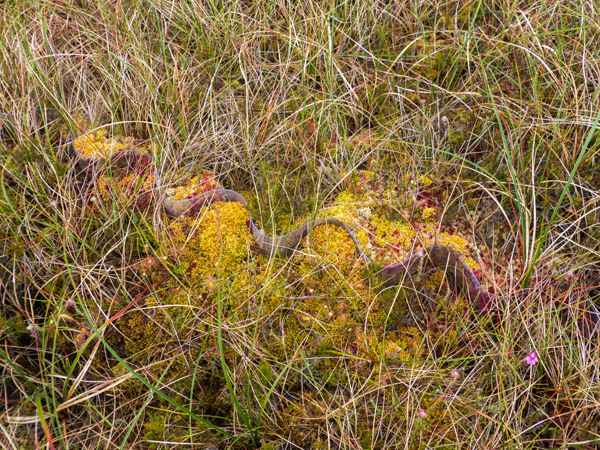
While this is excellent news for the bog, it meant that Jack and I were wading across ground that was harder to cross than the worst kind of soft sand-dune. Very exhausting, and on our longest day, too. Little did we know that things were to become even more exciting, even challenging, later in the day…
Luckily the weather remained kind all the way to our far transect point, and although the sky was a jumbled mass of cumulus, stratocumulus and cumulonimbus, the passing showers all passed either side of us. Occasional patches of blue gave swathes of bright sunshine which sometimes gave us views almost to the distant eastern coastline:
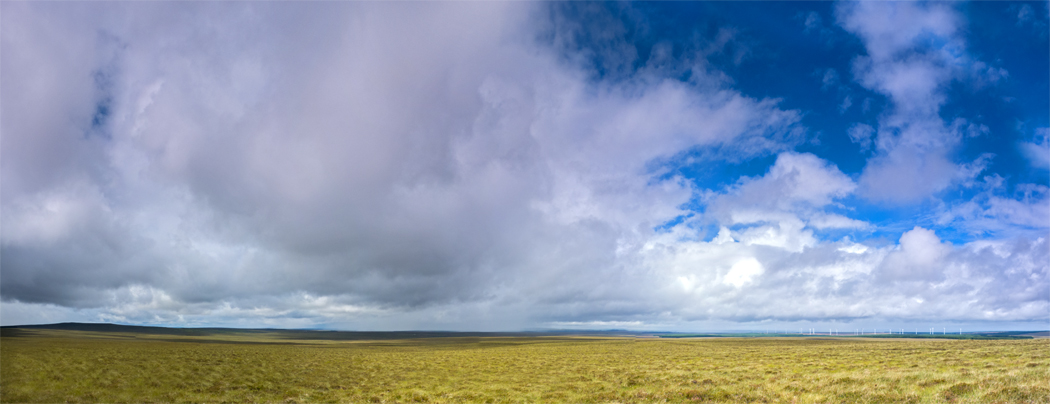

As we finally turned to head back, however, the clouds coming over the ridge from the west became increasingly ominous and threatening:
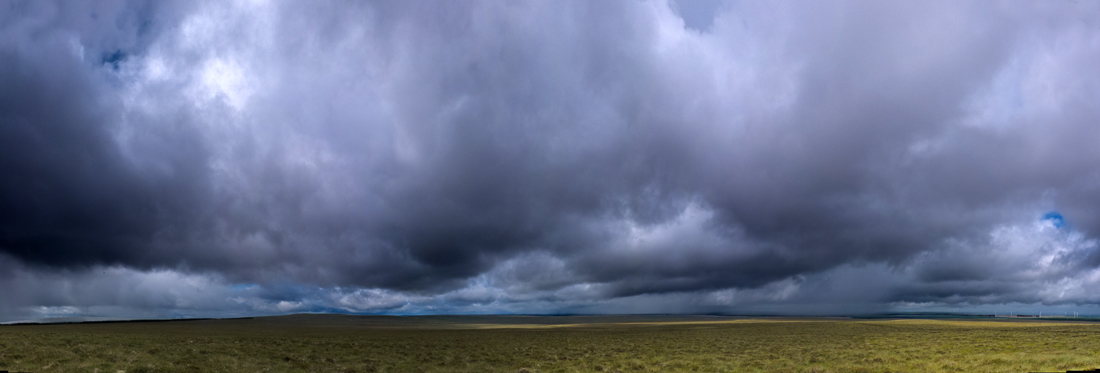
Within a short time we were walking straight into a series of drenching showers and the wind was blowing it straight into our faces. We still had one more transect to do…
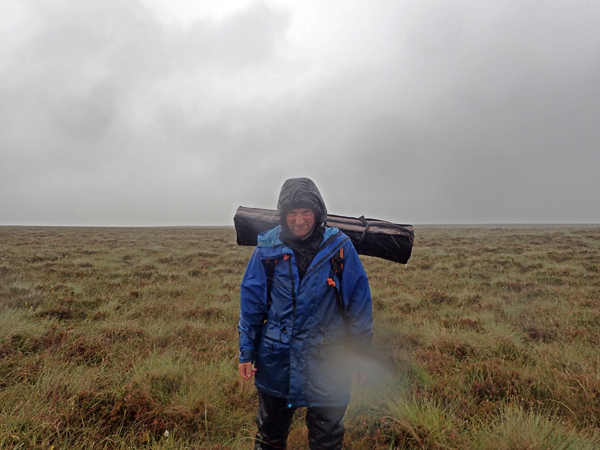
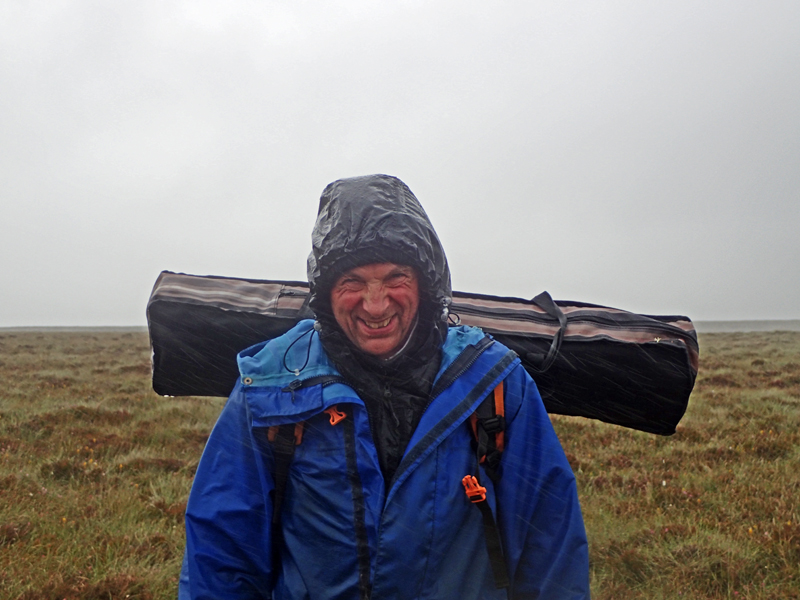
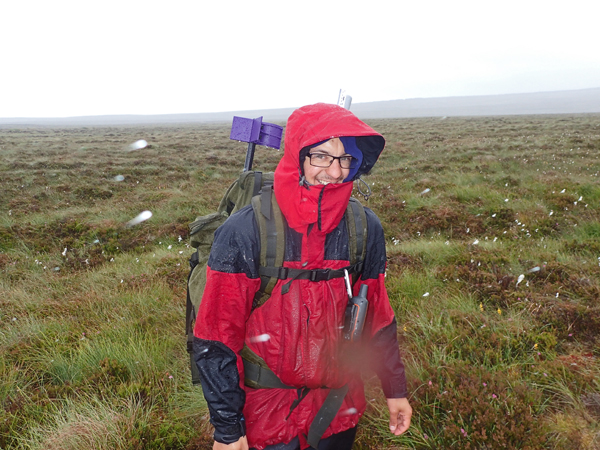
Fortunately the rain eased off while we completed our final transect of the 2016 monitoring, but then a huge black cumulonimbus came racing over the ridge towards us emptying everything it had onto the bog below. Jack and I looked at each other, contemplated walking face first into that lot and decided unanimously that we would use the folding camp-bed as a wind-break shelter from the coming storm:
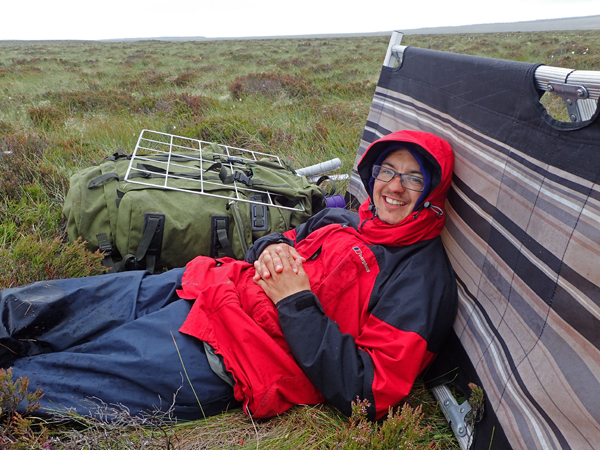
Indeed I made myself so comfortable behind our improvised wind-break with my head resting on my soft rucksack, combined with the release of tension after finally completing our transects for this trip, that I promptly fell asleep and started snoring gently:
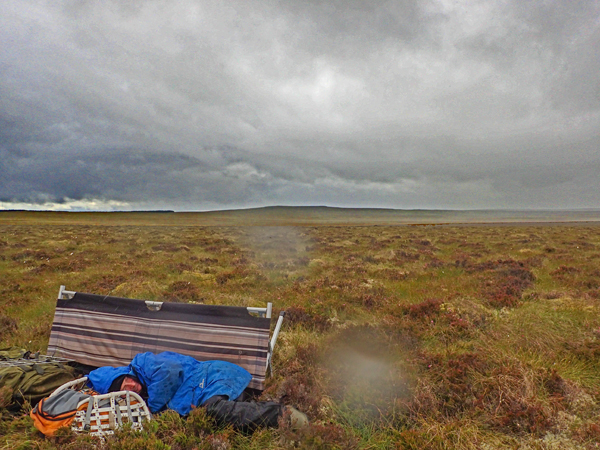
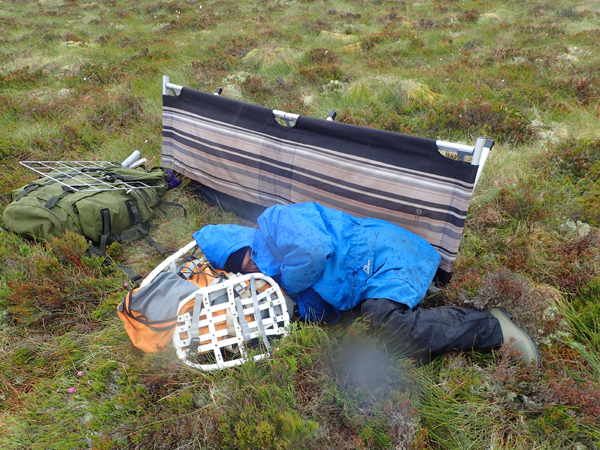
So soundly was I asleep that Jack began to worry that I must be in the second classic stages of hypothermia, when in fact I was very cozy and just completely relaxed. After the worst of the rain had passed, much to Jack’s relief I woke up refreshed and ready to go, so we packed everything up and headed back to Munsary Cottage and the waiting Land Rover – managing to get drenched twice more before we actually reached the cottage. To celebrate the end of the transect work, we drove back down the long track playing ‘Spring’ from Vivaldi’s ‘Four Seasons’, then the soundtrack to ‘Gladiator’ (we’re nothing if not eclectic) through the Land Rover sound-system – all very epic as we drove through the dramatic skies and wild landscape.
The dawn of our final day on site saw dramatic ribbons of stratocumulus streaming over ‘Northern Lights’, but fortunately it didn’t presage anything more uncomfortable than a somewhat chilly wind and a generally grey sky.
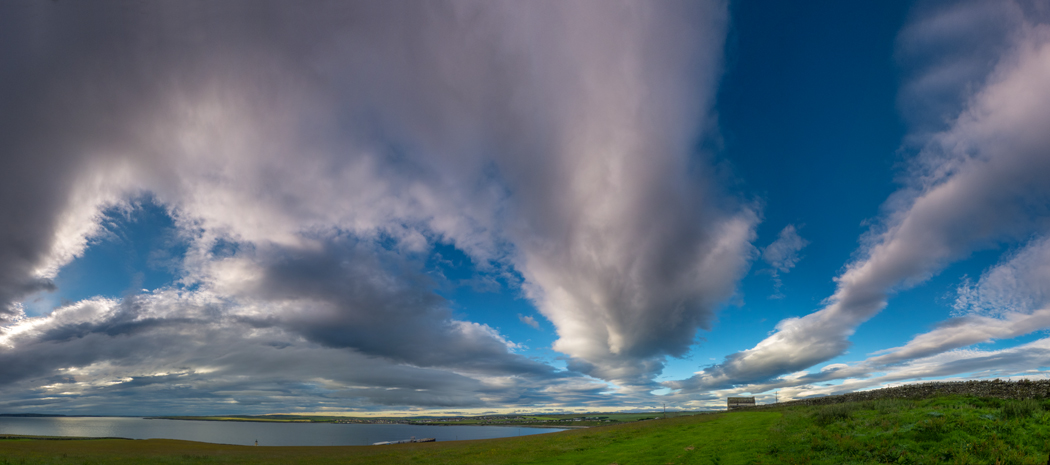
After finishing off our last tasks on site and obtaining some useful peat cores for Jerushah’s PhD, we headed back to Thurso for a celebratory meal at the Y-Not Inn, then back to ‘Northern Lights’ to begin packing for our departure in the morning. Munsary Monitoring 2016 was over (bar the analysis and write-up) and would now be passed to the ERI in Thurso for the next monitoring round, due in 2023…!
Floreat Munsary Peatlands…!
To finish, I just want to thank everyone who made this possible. As well as the team listed in Part 1 of this blog, I should also like to thank UEL for providing the REF-sourced funding to enable us to do the work, Davie Black of Plantlife for providing additional funding, the ERI in Thurso for providing so much assistance throughout, Jennifer Hartman for sorting out so much of our initial financing and purchasing, and Alan Chandler for offering the opportunity to seek REF-fund money for this work in the first place. I must then just say a final ‘thank you’ to the team – Jack, John, Roxane, Gearoid, Sam, Jerushah, Pete and Nathalie. The work would have been impossible – and much less fun – without you.
Munsary Monitoring, Caithness : Part 2
To continue the saga of the 2016 Munsary Monitoring Experience…
…the morning after the Day of Being Playthings of The Gods – or at least that’s what it felt like at times – dawned rather grey but at least it wasn’t actually raining.
The three teams set off to their allotted transects, me teaming up with Jack Clough and Nathalie Triches. Once I’d done the vegetation recording with Jack noting my calling-out on the record sheet, Nathalie took over to measure the microtopography, demonstrating an elegant form of ‘Laser-Levelling Yoga’…
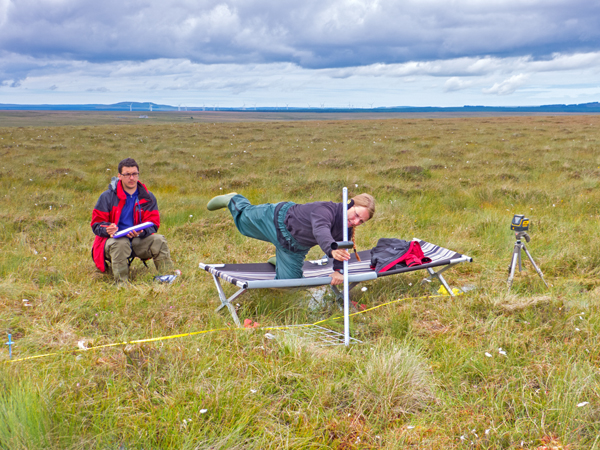
I, meanwhile wandered off to capture some of the bog plants in what was fast turning into a somewhat sunny day. The bog asphodel (Narthecium ossifragum) was looking rather fine, being the only obvious yellow flower in the general bog vegetation (tormentil is also yellow, but much less obvious):
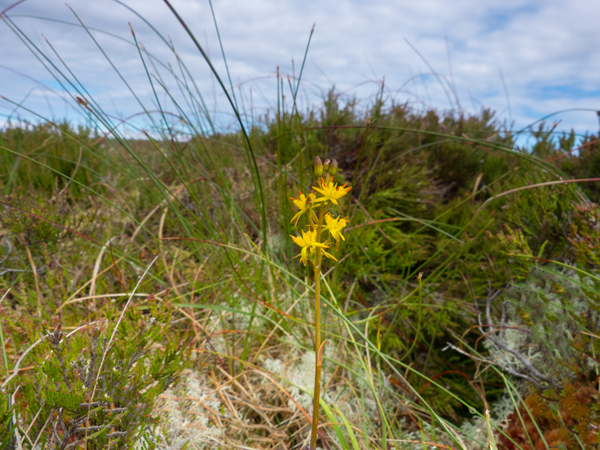

It’s the Sphagnum bog moss, however, that’s the key to the site and one of the main drivers of peat formation. As the sun started peeping rather bashfully from behind the increasingly broken cloud, the reds of Sphagnum magellanicum and S. capillifolium and the ambers of S. papillosum and S. tenellum shone like traffic lights in the bright sunshine, the Sphagnum sward being pierced by the sabre-shaped leaves of the bog asphodel and the stems of heather (Calluna vulgaris) and cross-leaved heath (Erica tetralix):
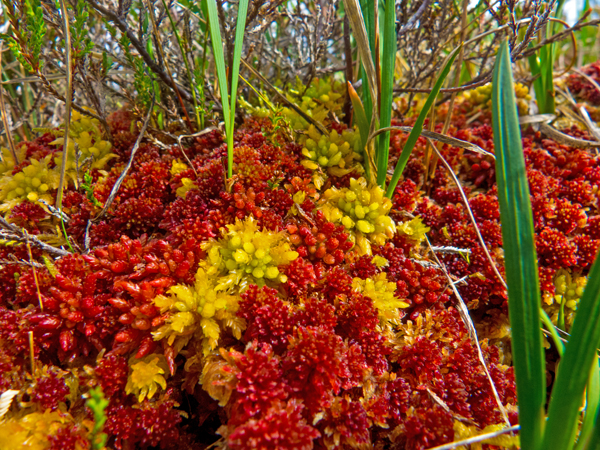
In the bog pools the large trifoliate leaves of bog bean (Menyanthes trifoliata) were reflected in the almost mirror-like water surfaces because the wind had dropped – which meant that the midges and clegs (horse flies) came out to play. Always a source of joy…
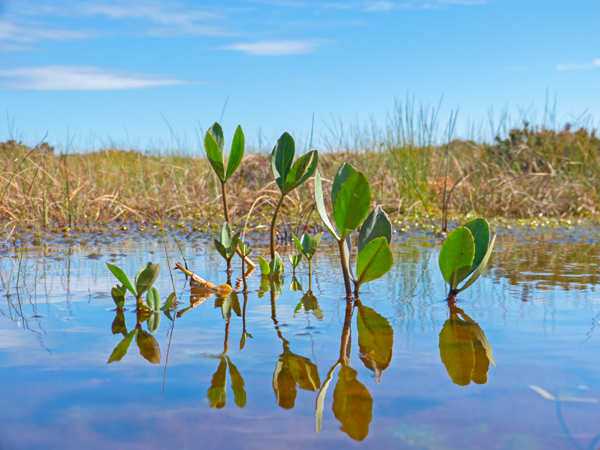
That evening, an orange moon rose above the fields to the east of Thurso and vanished into a steadily thickening bank of cloud. This did not look good for the following day…
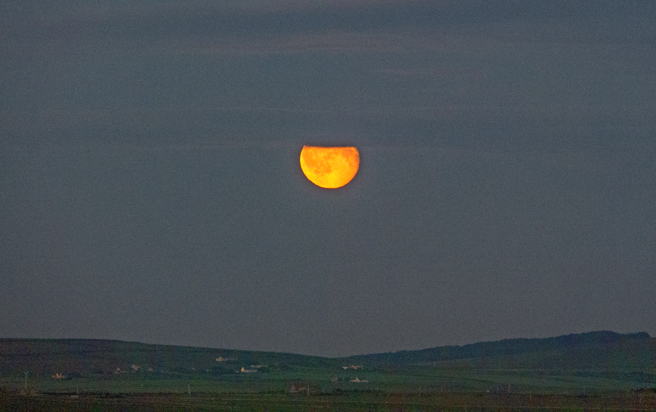
In fact so miserably damp was the following day that I didn’t bother taking many photos at all. I did manage a somewhat waterlogged view of the moss Hypnum jutlandicum growing across a Sphagnum sward within which can be seen (especially for John!) the green-purple ‘golf-balls’ of the leafy liverwort Mylia taylori, while the white stag’s-antler network at the top of the photo is the lichen Cladonia portentosa (formerly C. impexa) and the large green leaf slicing through the Sphagnum sward to the right is common cotton grass (Eriophorum angustifolium):
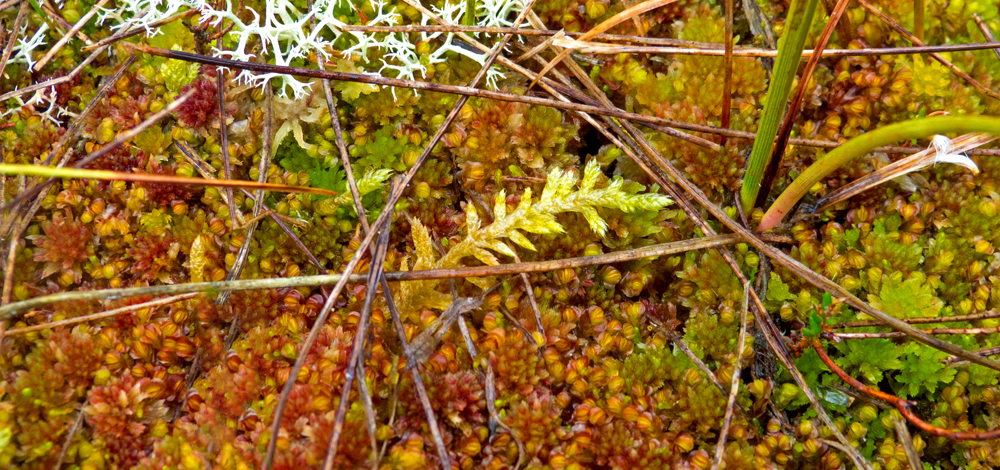
The pink flowers bunched at the top of grey-green heather-like stems are those of cross-leaved heath (Erica tetralix) – a species more characteristic than heather of wet, healthy bogs – here dappled with drops of the mizzly rain which accompanied us much of the day:
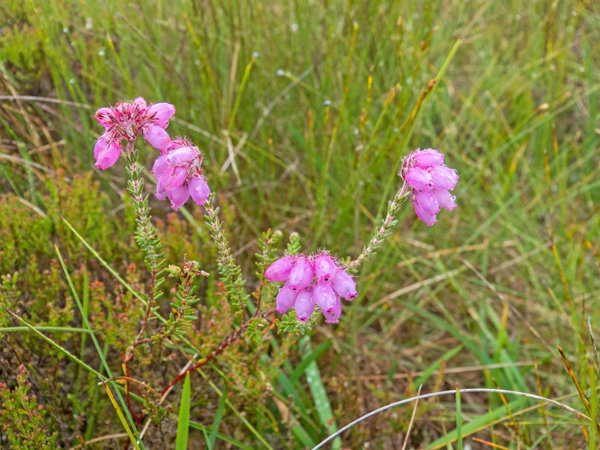
Leaving the site that evening, the sky to west looked like something from Mordor in Lord of the Rings, with thick roiling ridges of cloud being stirred by the Scaraben ridge and the summits of Morven and Maiden Pap:
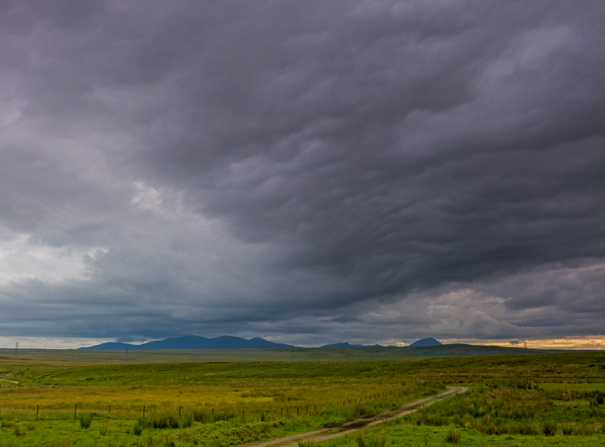
This really didn’t look good for tomorrow, and although the worst of the rain went hammering through during the night, the weather was pretty dire all day, with the result that I didn’t take any photos other than the standard stereo transect photos with the waterproof camera today.
Dawn the following day looked pretty spectacular at 5 a.m.
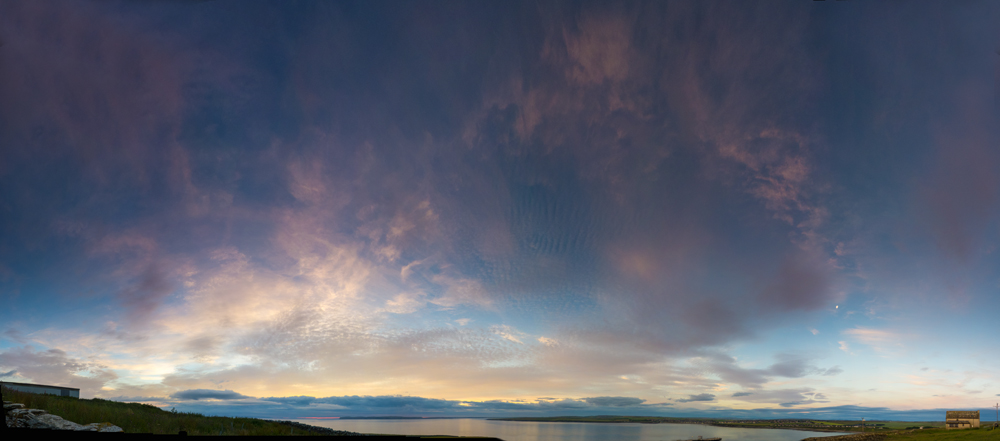
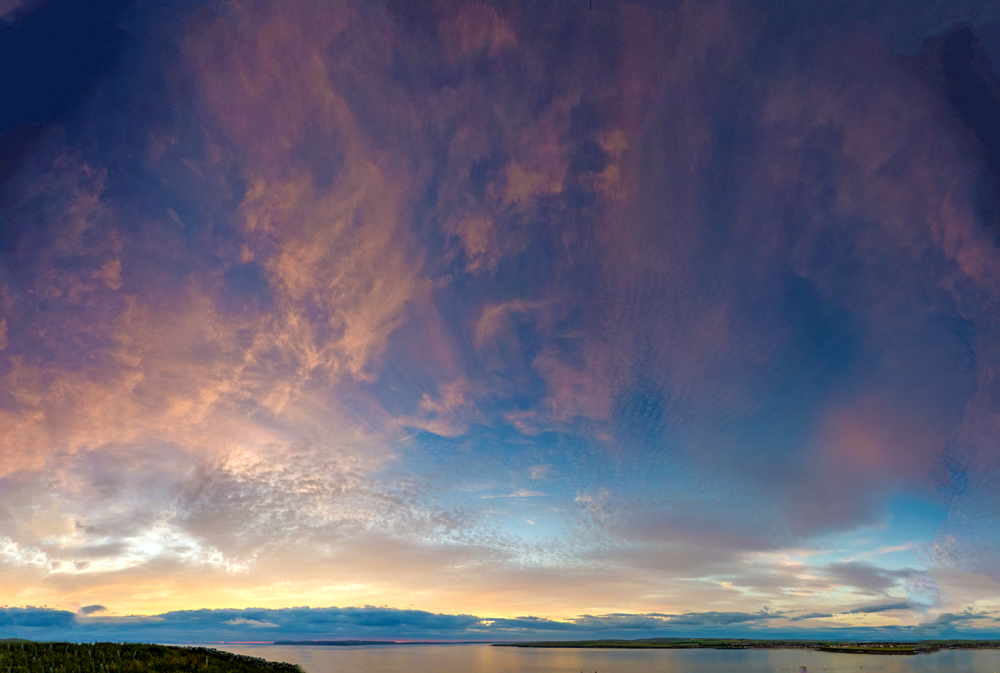
…and just to emphasise that we were in Scotland, here’s some heads of spear thistle (Cirsium vulgare) which woke me up very effectively as I was blundering about gazing up at the skies. I still have some of the thorn fragments in my thumb, visible as white spots as I type this:
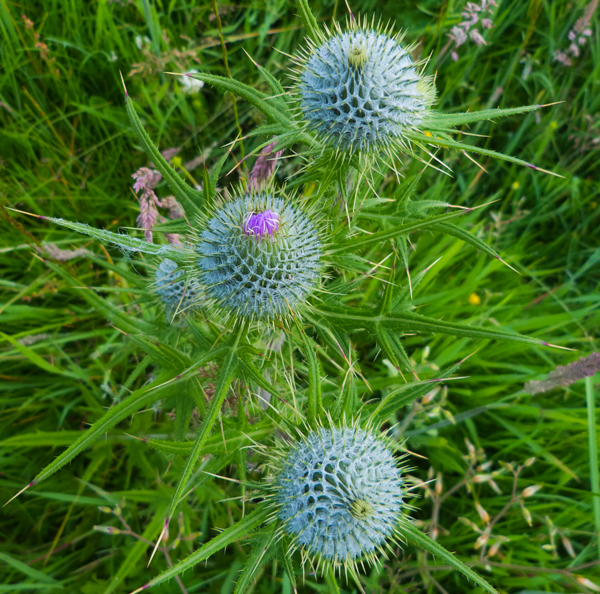
Within half-an-hour the sky over the Orkneys (the islands in the distance – or more specifically, the island of Hoy) had turned a speckled grey like the breast of a teal:
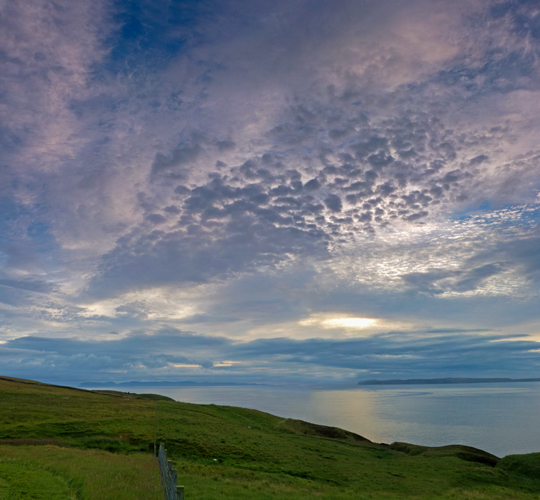
Meanwhile the sky to the west, advancing over our ‘Northern Lights’ cottage (to the left of the photo), was a confusion of high cirrus, cirrostratus, cirrocumulus and dark banks of altocumulus:
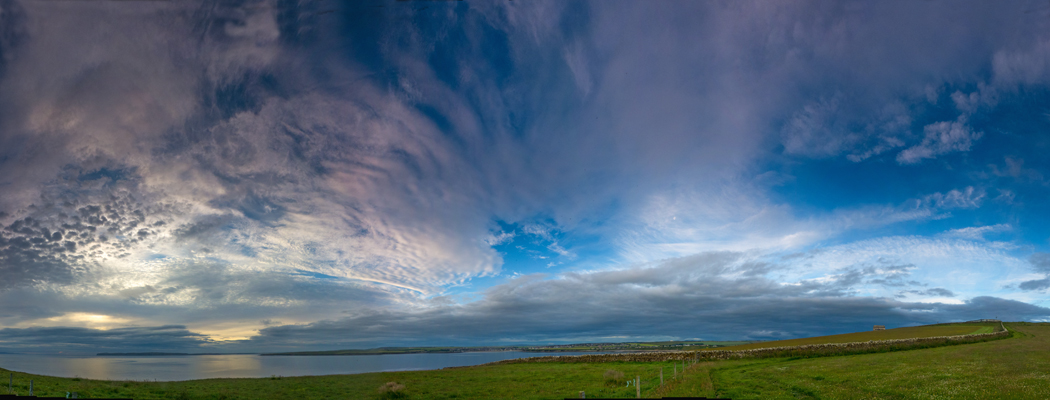
As I watched, the altocumulus thickened, darkened and advanced across the sky, presaging miserable weather yet again for our working day:

We spent the day checking fixed markers to see whether the bog surface showed any signs of movement. An interesting exercise, but the drenching mizzly rain made it less than fun much of the time. One advantage of the rain was that it brought out the ‘dew’ droplets of the sundews, with some particularly striking examples of great sundew (Drosera anglica):
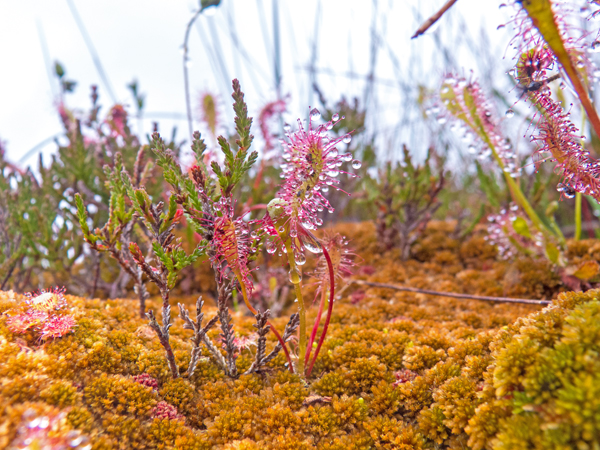
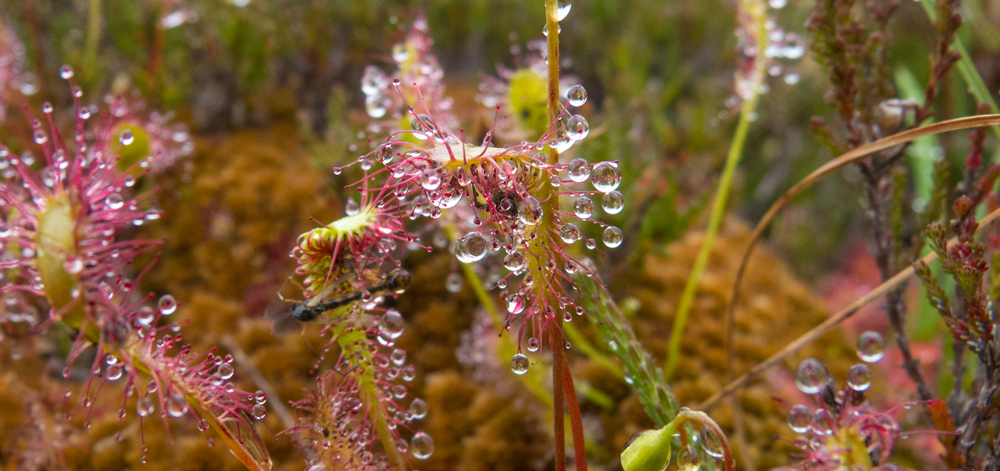
…and even the rather more self-effacing round-leaved sundew (Drosera rotundifolia) resembled a little jewelled brooch:
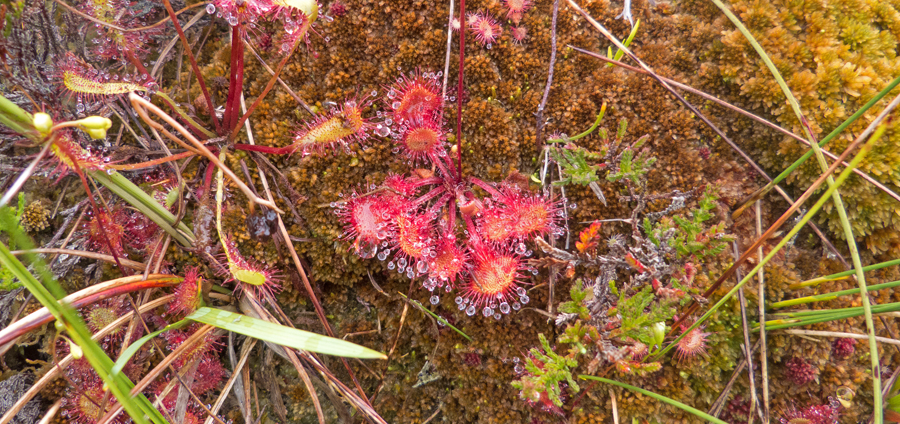
Meanwhile the common cotton grass (Eriophorum angustifolium) seed heads were looking their cottony best. These make poor woven material but were used to make bridal stockings in the Scottish Highlands because the material is so soft and could cope with one evening’s wedding ceilidh dancing:
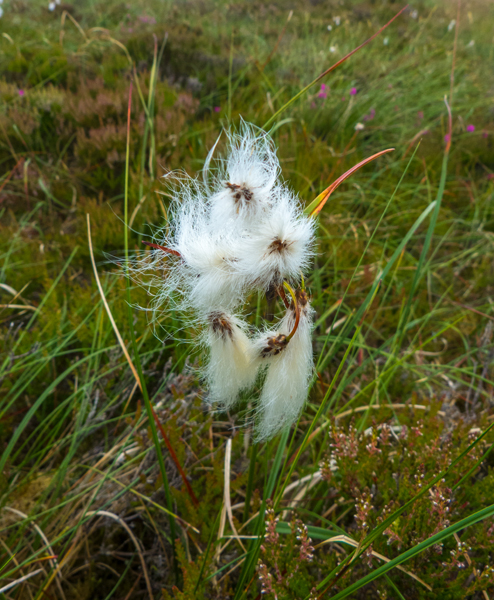
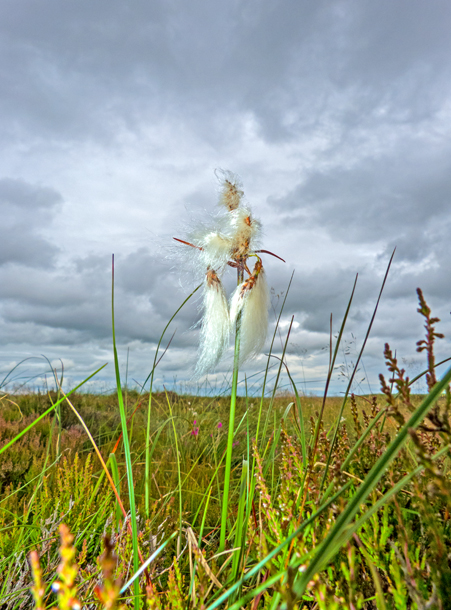
Damp, but with much animated discussion about some rather interesting results, we headed back to Northern Lights to prepare dinner and cross our fingers that all the rain was now sufficiently bored with Caithness that the rain-clouds would finally drift away eastwards and leave us with a dry day on the morrow. To find out whether our hopes were fulfilled (and discover the secret of the body lying on the bog), you’ll have to wait until Part 3 of the Munsary Monitoring Experience.
Munsary Monitoring, Caithness : Part 1
The last two weeks of July were spent up in Caithness, carrying out repeat monitoring of Plantlife’s Munsary Peatlands Reserve. The monitoring of the reserve is undertaken on a 7-year cycle. We established the baseline in 2002, then undertook the first cycle of repeat monitoring in 2009. Consequently 2016 represented the second cycle of monitoring. The second cycle is exciting because this gives three points on the curve of trends, giving a clearer picture of where the site is going in response to Plantlife’s management of the reserve.
Details of what we did and what we found will appear in our report to Plantlife in due course, but this blog is about the experience of doing the monitoring work and being up in the far north. In fact most of the blog is about the amazing skies (and the consequent weather)…. (click on photos to see them full-size)
Plantlife’s Munsary Peatlands Reserve lies less than 30 miles south, by road, of both John o’ Groats and Dunnet Head – the latter being the true location of the most northerly point on the British mainland. The reserve itself is located down a very long and very difficult track which begins a little way off the A9 some 20 miles south of Thurso, the County Town of Caithness and itself located on the north coast. A ‘robust 4×4 vehicle’ is the only sensible way down the track, which is in any case not generally open to visitors, so we hired a long wheelbase Land Rover Defender for the two weeks. The two-day journey north from London felt, as it always does with a Land Rover because of the large all-terrain tyres, rather like riding a slightly skittish horse that needs to be constantly encouraged back to the correct route, so it was a relief to arrive at ‘Northern Lights‘, the self-catering cottage overlooking Scrabster and Thurso, which was to be our base for the next two weeks.
We were undertaking the work in partnership with the Environmental Research Institute (ERI) of the University of the Highlands and Islands (UHI), so our first day out at Munsary Cottage in the middle of the reserve saw us assembling the equipment needed for a training and standardisation day with everyone to ensure that we would all be recording in the same way over the coming days. The UEL team consisted of myself, Jack Clough (Research Assistant), Jerushah Jardine (PhD student), John Riggall (former NCC Peatland Team colleague) and Sam Jelliman (taking a break from Sustrans), while the UHI team consisted of Roxane Andersen (ERI Research Fellow), Pete Gilbert (ERI Technician), Nathalie Triches (an ERI intern student from Switzerland) and Gearoid Murphy (taking a short break from the RSPB).

John Riggall demonstrates the use of the self-levelling laser to measure microtopography while balancing on our Outwell camp beds to prevent trampling disturbance to our permanent transects:

Dawn on the next day saw a golden (rather than red) sunrise towards Dunnet Head and across the Pentland Firth towards the Orkneys, potentially promising a good day:

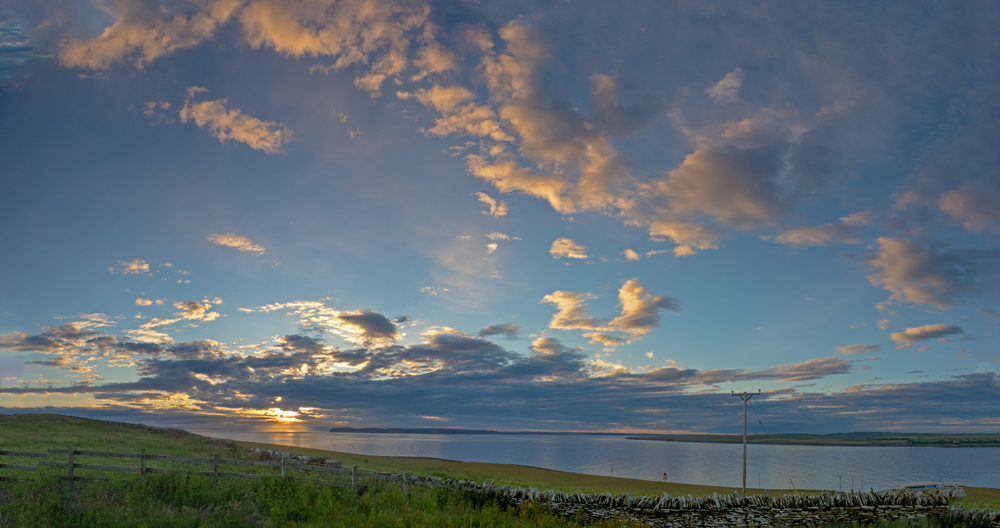
Once out at the cottage the sky was blue and the day looked like being a hot and sweaty tramp across the bogland. It was the first day of being divided into teams, so some time was spent sorting the three sets of equipment:

…until we had each team loaded with its own rucksack of essential gear. Here’s Roxane all ready to go with a rucksack almost bigger than her, while Sam checks the GPS coordinates of their first transect of the day:

As we were walking out to Rowens Dubh Lochs a red deer hind galloped past across the bog towards Munsary Cottage:

Meanwhile the sky had cleared to leave just a few isolated cumulus and much hot sunshine blazing down onto the expanse of bog-swathed landscape:
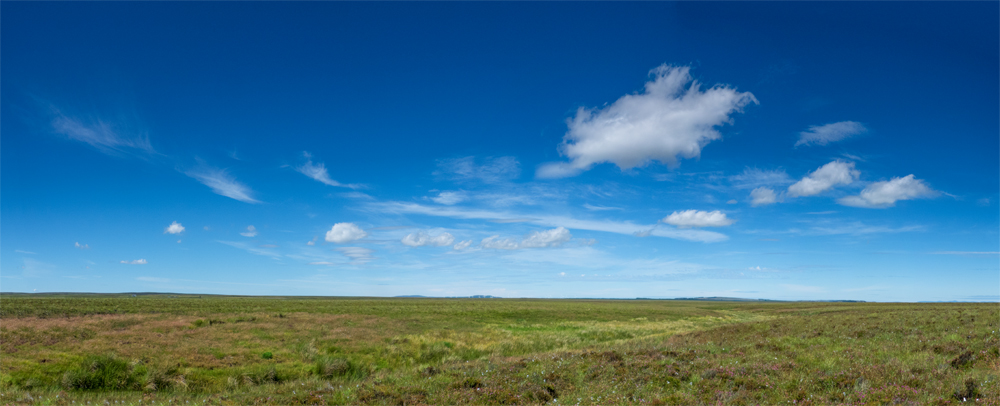
Once at Rowens, we separated into three teams. Having arrived at the general vicinity of their first transect, Gearoid and Roxane watch as Pete straps on snowshoes before carefully seeking out the exact location of the transect, which we do using our Bill Wyman metal detectors (yes, that Bill Wyman!):

Amidst all the to-ing and fro-ing and recording, I managed to snatch a photo of bog asphodel (Narthecium ossifragum) in flower. Its scientific name ‘ossifragum’ reflects its country name of ‘bone-breaker’, being reputed to cause brittle bones in stock who graze on it. It may indeed contain an enzyme which makes bones more brittle, though this is not confirmed, but what is certainly clear is that stock grazed on a rain-fed peat bog will receive little calcium from their grazing and may thereby develop weakened bones. It is a member of the Lily Family, and the German name is ‘Moor Lily’, which is rather more lyrical than the British ‘bog asphodel’, or ‘bone-breaker’…

Driving off the site that evening, we were confronted by a crazy cirrus sky surrounding the setting sun to the west and blotting out half the sky. This did not bode well for the morning…
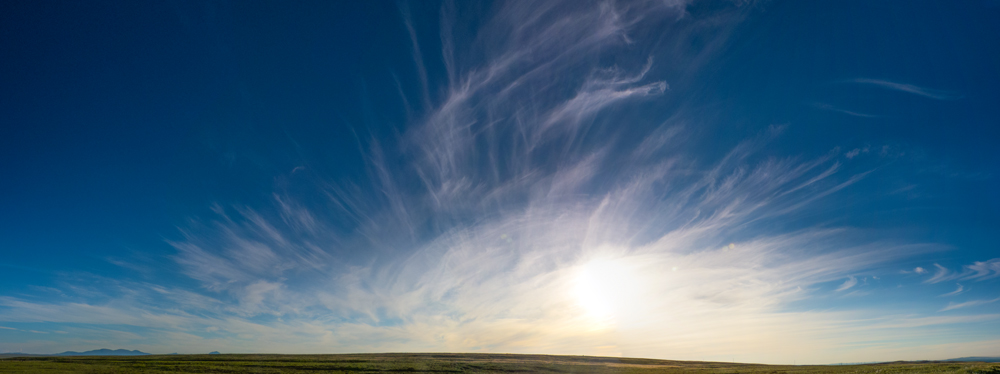
Things did not improve as the evening wore on, with the final sunset bringing long streamers of cirrus racing out of the west, then vanishing to the east over our Northern Lights cottage and off towards John o’ Groats:
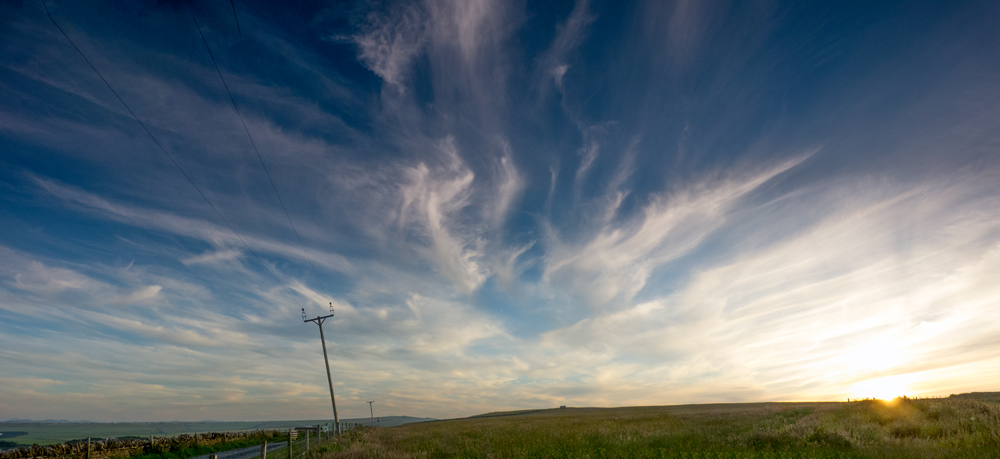

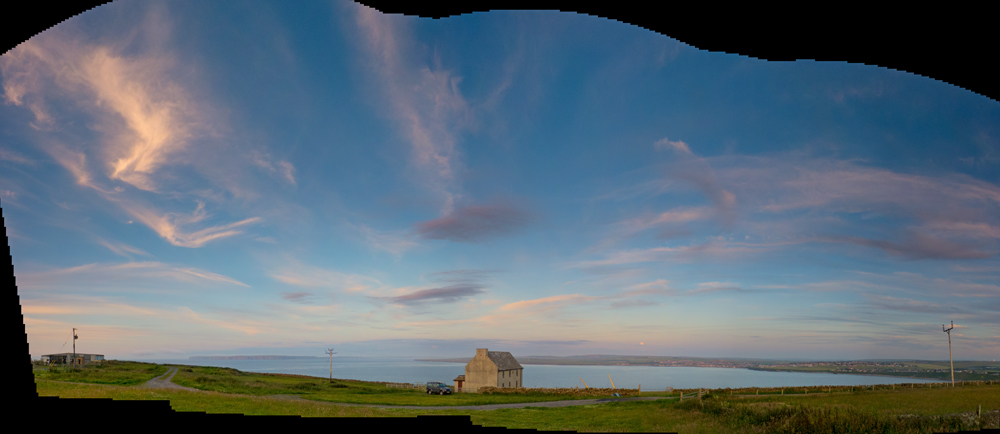
That night all hell broke loose, with thunder, lightning and tremendous deluges of rain. The wifi in our cottage was completely fried by one particularly spectacular bolt of lighting about 2 a.m., although by all accounts things were even worse further south in Scotland.
We awoke to the distant rumble of thunder and a threatening mizzly rain. Heading out along the track we encountered a bovine traffic jam:


Having negotiated the cattle, we arrived at Munsary Cottage to the increasingly loud rumbles of thunder. Heading off towards the main Munsary pool system and carrying large metal rods, metal camp-beds and metal detectors, we became increasingly dismayed as the thunder headed slowly but surely towards us. By the time we’d arrived at our transects the rain was coming down in monsoon quantities, almost making it difficult to breathe, and then the lightning started flashing down all around our own horizon. I tried calling up the other two teams on the radios to suggest we consider abandoning things, but there was so much static and rain noise that we just couldn’t hear each other and besides the long walk back was likely to be just as dangerous as remaining where we were. A double bolt of lighting hitting the wind turbines not far from where John’s team was working led him, wisely, to suggest that his team lie down in the heather for a while – a suggestion which his team members adopted immediately and with some enthusiasm. The other two teams were in such a wet area that lying down wasn’t an option – unless team members preferred drowning to being struck by lightning. Still, we were all wearing rubber waders, we kept some distance from the metal equipment for a while, and the lightning never approached nearer than a mile or two, so we just worked steadily on through the storm and eventually it became bored and drifted away to cause mayhem and excitement elsewhere.
Unsurprisingly, there are no photos of this event even though we had waterproof cameras with us, partly because the sky became so dark that there was little light, partly because the rain was so heavy that all the photo would have shown would have been water streaming down the lens of the camera, and partly because we were simply in survival mode – get the transects done and leave the area as quickly as possible. Get the transects done we did, however, despite the conditions, but this was not the last occasion when it became a case of ‘undaunted by weather’ – the motto of my father’s Coastal Command 519 Squadron responsible for meteorological flights during the war – from Wick, just 15 miles west of Munsary, as it happens – and a motto adopted after this day by the Munsary Monitoring Team…
What, however, are we to make of this body lying on the bog some days later…? All will be revealed in a subsequent post…
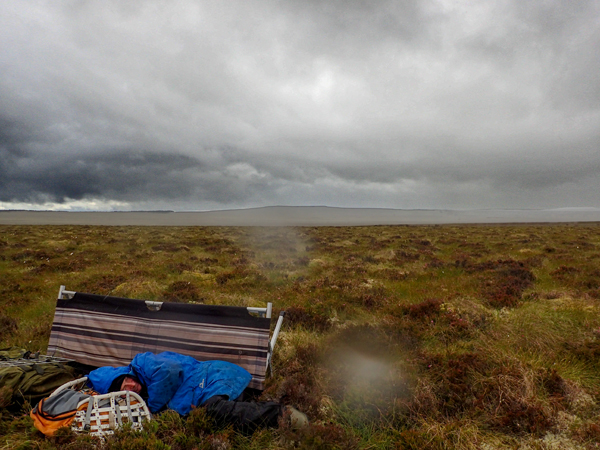
Myland sunsets : 9th July 2016
Now here’s a thing… I was plodding through the many photos taken while commuting up to Birmingham and back to speak at a hydrogeology workshop, then to and from Peterborough to help celebrate the retirement of Dave Chambers (he of Merlin Magic fame), when I suddenly spotted a pinkish glow out of the window of the study. Pinkish glows around sunset usually indicate that I should be grabbing my camera so I did just that. The sight which met me as I rushed out of the door clutching camera, tripod and folding stool took my breath away. I was torn between running as fast as I could to the local fields, or up to the local park behind the house just to catch something before it all began to fade. In the end I chose the park and even then I wasn’t quick enough to catch the most spectacular aspects (and it is worth clicking on the images to see them at full size – browser back-arrow to return to blog):

Within two or three minutes the sky was darkening and the golden glow was fading from large stretches of the sky:

But here’s the thing – there were several people in the park, walking dogs, practicing their basketball hoops or kicking a football around – but no-one was looking at the sunset apart from me. Here was this extraordinarily spectacular phenomenon going on right above their heads but no-one seemed interested. I just don’t get it. People pay hundreds, sometimes literally thousands, of pounds to travel to the far north of Finland to see the Northern Lights, but here was a phenomenon which far outshone those glowing curtains (I know because I’ve seen the Northern Lights twice, once in Shetland, once in Caithness), yet it attracted no interest. If it had been the Northern Lights, people would probably have been rushing out of their houses and commenting to their neighbours about what a spectacular display it was, but here was something equally worth of comment yet it was going largely unremarked – except for a slightly deranged character sitting on his little folding stool in the centre of the playing field gazing open mouthed at the sky while frantically trying to take photo-panoramas with the camera balanced precariously on a tripod. All very odd – and I’m not referring to the slightly deranged character…
Anyway, I then tried sprinting to the fields to catch what was left of the sunset across the wheat fields, but by the time I arrived (no more than 4-5 minutes later) the sunset had all-but ended, leaving a darkening mauve and grey sky which, earlier in the day had been threatening rain within 24 hours:

Perhaps it will rain later tonight, or maybe we will wake to another soggy Sunday. Still, at least the rain is now warm (it being summer)…
What the Commuter Saw : 5th July 2016
High cirrus ‘mares’ tails’ on Saturday promised rain on Sunday – which duly arrived – then on Monday things were rather more showery but the sunset suggested that Tuesday would be dry. In Colchester the morning brought grey and white stratocumulus which dominated the sky all the way to London. Things were breaking up and brightening up during the run from Stratford to Galleon’s Reach DLR, so the UEL Docklands Campus was bathed in sunshine with scattered cloud. By the journey home from Stratford the sky was looking calm and settled, with large expanses of blue sky and small bands of cumulus fractus or cumulus humilis near the Lone Oak east of Shenfield:

By Galleywood the bands had thickened slightly over the fields of ripening wheat, but there was no sign of the clouds building up into cumulus congestus or cumulonimbus calvus – with their drenching showers:

Between Kelvedon and Marks Tey there were hints of stratocumulus development but without any real conviction, and in fact the dusk saw even these bands fade away to leave a clear sky:

This calm sky is good news because tomorrow is School Sports Day for my Little Helper (we are apparently slightly nervous about this…) after having been postponed because of the torrential rain two weeks ago.
What the Commuter Saw : 30th June 2016
A sky of confusion and contrasts today, though with remarkably little rain, which makes a change. The sky above the Colne Valley weir was dominated by cumulus, but there was a hint of a thin, veil of cirrostratus high above that:

This continued through to the fields west of Witham:

…but by the time Abellio Greater Anglia had left Chelmsford and was running us unusually slowly past Galleywood and Billericay, the cumulus congestus clouds were evidently building up and potentially heading for full-blown development of cumulonimbus and the inevitable rain:


By the time we had reached the Lone Oak east of Chelmsford, the sky seemed to be turning somewhat mad, with cumulus piled upon cumulus, although by the Lone Oak itself there was a hint of blue sky:


Arriving a while later at Galleons Reach DLR Station, the cumulus had developed into long cloud streets running directly between me and Canary Wharf:

The view from the UEL Docklands Campus down Royal Albert Dock towards Canary Wharf was dominated by spectacular cumulus cloud streets, but above these ribbons of low cloud there was still a suggestion of a high cirrostratus layer:


Although the great-crested grebes have now gone from the dock, a shellduck flew past and settled in the middle of the dock:

Walking back to the DLR that evening, I was struck by the fact that the wild carrot (Daucus carrota) is all coming into flower now, with some still forming unopened umbells of pink and white while adjacent plants are in full bloom, with their characteristic spot right in the centre of the umbell:

Once on the train from Stratford to Colchester, the clouds around the Lone Pine after Shenfield were simple cumulus, but they were increasing in complexity all the time:

By the time we’d reached the fields west of Witham the sky was looking increasingly threatening as the cumulus began piling together to create a high, dark cumulonimbus cloud (which usually means rain):


By Witham the ska was completely cloud-covered and it looked as though rain would at any moment start pouring from the dark grey masses of swirling cloud:


Then, unexpectedly, a patch of blue sky broke through:

…which was quickly extinguished by the surrounding roiling clouds…and by the time we had reached the Colne Valley weir again things were looking pretty gloomy once more:

However, when I continued on from the station to collect daughter from the gym, the adjacent meadow was becoming increasingly bathed in sunshine as the thick layers of cloud headed off eastwards, seemingly at a leisurely pace but actually they must have been moving at quite a speed:

Consequently and unexpectedly, the day ended with blue skies and a sun-dappled, flower-rich meadow:


What the Commuter Saw : 21st and 27th June 2016
This is the Chinese Year of the Monkey, which apparently brings turmoil and change to everyone. Given the political events, and the nature of the weather, since the start of the year I am forced to consider that there may be something in this… The last week alone has seen the shock Brexit vote, flash floods (during which James Knowles commuted past a flood-stranded London bus on a lilo), David Cameron’s resignation and even talk of a snap General Election. The sky has mirrored this chaos by flipping wildly from fair-weather cumulus to threatening banks of cirrostratus to huge cumulonimbus calvus and back again, all seemingly within half an hour of each other. It has, however, made for some fabulous sunsets (see, for example, earlier posts) and some interesting cloudscapes while journeying between Colchester and Stratford London courtesy of Abellio Greater Anglia.
On the 21st June there was not much to photograph on the journey into London because it was largely clear blue skies with few clouds, although a distant band of fair-weather cumulus added some interest to the fields just west of Witham:

The cumulus had built up somewhat by the return journey, and was catching the pink of the sun as it slid down towards the north-western horizon, giving some fine views towards Billericay and Galleywood:


By the time we were leaving Chelmsford the sky was taking on a wilder look, dominated by high banks of cirrus and cirrostratus forming a great cauldron over New Hall School, the Hanson Aggregates tower, and the fields just west of Witham:



By Marks Tey, however, the cauldron had turned into a rippling lake of milk made up of cirrocumulus stratiformis and floccus:

There then followed several more days of rain and sun, and momentous political upheavals, but the morning of 27th June brought banks of cumulus humilis in what looked like a day of calms and summer sunshine:

Incredibly, given the strength of the rain that we have had recently, the wheat in the fields between the ‘White House’ and the railway line shows no sign of having been flattened by the rain, and is growing vigorously:

Larger banks of cumulus over the fields west of Witham threatened to begin building up into rain-bearing cumulonimbus calvus:

…but over the Hanson Aggregates tower and New Hall School to the east of Chelmsford these faded back into a cross between cumulus humilis and altocumulus stratiformis – an interesting combination which could subsequently develop in a variety of ways:


Walking from Galleon’s Reach DLR Station to the UEL Docklands Campus, it was good to see the full range of wildflower meadow species at last in flower. The mallows in particular are now out, adding their pinks to the purples of the common knapweed, the yellow of the bird’s-foot trefoil and the white of the ox-eye daisies. The musk mallow (Malva moschata) is pale, and attracts moths at night:

…while the common mallow (Malva sylvestris) is a darker pink/purple with dramatic guidelines directing nectar-feeders to the nectaries:

Later, waiting on Platform 10 at Stratford Station, I realised that we had a mini-rainbow (actually a ‘circumzenithal arc’) directly above us in the high cirriform ice crystals. In his wonderful ‘The Cloudspotter’s Guide’, Gavin Pretor-Pinney calls this ‘the cloud smile’ and (as Richard Hamblyn in ‘The Cloud Book’ notes) it means that the sun must have already sunk to within 32 degrees of the horizon:

These high ice crystals coalesced rapidly during the journey, and by Chelmsford were creating a wild cirrostratus fibratus sky which steadily thickened towards Colchester. Rain is on the way – and indeed although today began bright enough, by mid-afternoon we have had yet more heavy showers:



Still at least the rain is now warm… so summer must finally have arrived – which explains why wife and daughter each bought a pair of wellingtons at the weekend…


